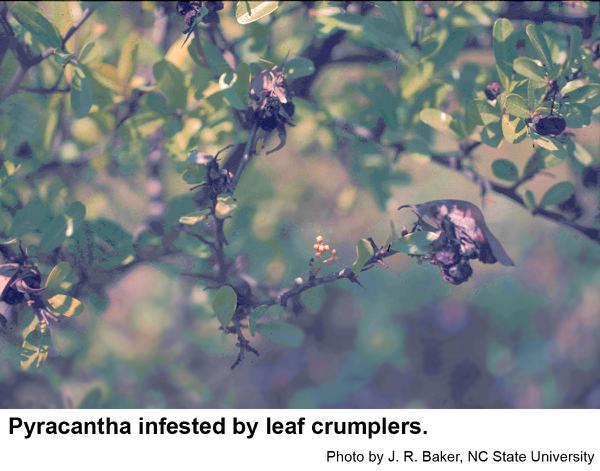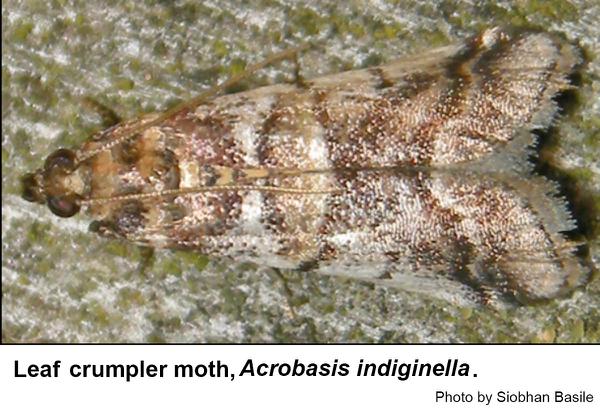Description and Biology
Leaf crumplers, Acrobasis indiginella, are small caterpillars that spin tubes of silk on host plant stems. The tubes web together leaves that eventually die and form the conspicuous wads of dead material that resemble dieback perhaps caused by fire blight. These small caterpillars grow to about ¾ inch long. Their heads are pale reddish brown, and the top of their bodies are grayish green with some purplish markings, particularly where the segments overlap. The undersides are pale grayish green. The worms pupate in the tubes in late July to mid-August. Mature leaf crumplers molt into pupae that are just over ¼ inch long and are yellowish brown to reddish brown. About two weeks later, small leaf crumpler moths appear. They have a wingspan of ½ to ¾ inch. The forewings are light brown with a white patch on each wing and several black lines. In North Carolina we have two generations of leaf crumplers each year. Eggs are deposited on the foliage, and they hatch in 2 to 3 weeks. The larvae construct tubes that are attached to twigs of host plants. As the larvae mature, they expand their tubes with silk and leaf fragments. The sinuous tubes can be up to ¼ inch wide and up to 1 ½ inch long when the leaf crumplers are fully grown. In late July and mid-August, the leaf crumplers seal over the ends of the tubes and pupate. Pupation lasts about 2 weeks. Leaf crumplers overwinter as partially grown larvae in the tubes on the host. In spring, the leaf crumplers become active and resume their feeding. These larvae pupate about the middle of May. During the winter, the first ¼ inch of the reddish brown tube may become detached from the host. The leaf crumplers seal up the open end so that the end of the tube is flat. They first feed on developing leaves near their tubes; but when the adjacent food supply is depleted, they leave their shelters in search of more plant material, usually at night. Leaves brought back to the tube frequently dry and become unpalatable. The accumulation of dry leaves can offer communal protection for two or more leaf crumplers.
Host Plants
Apple, cherry, cotoneaster, crabapple, hawthorn, loquat, peach, pear, plum, pyracantha, and quince are recorded hosts of the leaf crumpler. Damage is caused by the feeding of the larvae and the tubes and clusters of leaves they form. Girdling of the twigs and feeding on the buds and fruit (probably caused by crowding) have also been reported.
Residential Recommendations
Sevin or some other insecticide labeled for landscape use in home grounds should give adequate control if applied thoroughly enough to get the pesticide mixture into the nests.
References
- American moths of the subfamily Phycitinae. Heinrich, C. 1956. US Nat. Museum Bull. 207. 581 pp.
- Insect and Related Pests of Shrubs. Baker, J. R. ed. 1980. NC Agricultural Extension Service publication AG-189. 199 pp.
- Taxonomy of Acrobasis larvae and pupae in eastern North America (Lepidoptera: Pyralidae). Neunzig, H. H. 1972. USDA Tech Bull. 1457. 158 pp.
- Extension Plant Pathology Publications and Factsheets
- Horticultural Science Publications
- North Carolina Agricultural Chemicals Manual
For assistance with a specific problem, contact your local N.C. Cooperative Extension Center.
This Factsheet has not been peer reviewed.
Publication date: March 2, 2017
Reviewed/Revised: Oct. 1, 2019
Recommendations for the use of agricultural chemicals are included in this publication as a convenience to the reader. The use of brand names and any mention or listing of commercial products or services in this publication does not imply endorsement by NC State University or N.C. A&T State University nor discrimination against similar products or services not mentioned. Individuals who use agricultural chemicals are responsible for ensuring that the intended use complies with current regulations and conforms to the product label. Be sure to obtain current information about usage regulations and examine a current product label before applying any chemical. For assistance, contact your local N.C. Cooperative Extension county center.
N.C. Cooperative Extension prohibits discrimination and harassment regardless of age, color, disability, family and marital status, gender identity, national origin, political beliefs, race, religion, sex (including pregnancy), sexual orientation and veteran status.


